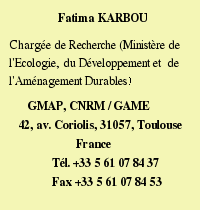

 |
|||||||||||
 |
 |
 |
 |
||||||||
 |
|||||||||||

 30/06/2007 |
 |
Microwave Land Emissivity For Data Assimilation Overview
Satellite microwave observations are still not fully used over land within assimilation systems in spite of their
large information content. So far, only observations that receive the least contribution from the surface are assimilated.
New developpements have been carried out at CNRM/GAME to extend the use of microwave data to the land surface. Three methodologies have been developed for AMSU-A, AMSU-B and SSM/I (Karbou et al. 2006),
and have been implemented in the ARPEGE 4D-Var assimilation. The
first method (1) uses averaged emissivity atlases derived from microwave
surface channels averaged over 2 weeks prior to the assimilation
period. The second method (2) uses emissivity estimates dynamically
derived, within the assimilation
system, for each atmospheric situation and for a selction of microwave
channels. For AMSU-A, emissivity is calculated at 31GHz and then
given the remaining channels. For AMSU-B, emissivity is calculated
at 89GHz and then allocated to the other AMSU-B channels.
For SSM/I, the emissivity is calculated at 19V and 19H: channels with a
horizontal (vertical) polarization use 19H(V) emissivities.The
third method (3) is based on the first one with dynamical skin temperature
estimation using one surface channel.
Of course, channels that are used to calculate the emissivity or the
skin temperature are discarded from any other computation or diagnostic
to ensure that the same information is not used twice during the
assimilation.
Experiments at METEO-FRANCE
The new methods have been tried in the French 4D-Var system and their results have been compared
with those obtained using the operational system.
All land schemes have been evaluated by examining the performances of the 4D-Var
observation operator prior to the assimilation. The performances of
the observation operator have been examined in the sense of two
diagnostics: (a) observation departure from first guess and (b) number
of observations that could be used. The results of the comparison show a significant improvement in the fg-departure
statistics (mean/std) when the surface is updated with the new surface schemes.
The study indicates that additional AMSU-A, AMSU-B and SSM/I channels could indeed be assimilated,
provided an adequate land configuration was chosen. AMSU-A channels 2 to 4 and
15 as well as AMSU-B channel 2 present satisfactory statistics that
could allow their use in the 4D-var system.
However, if an experiment allows the use of a greater
number of observations, it is does not necessarily improve the
forecast skills. Therefore, additional analysis should be done in order to give general conclusions.
Experiments at ECMWF 4D-VAR experiments at ECMWF have been
conducted to improve the assimilation of temperature sounding
observations from SSMI/S over land.
Land surface emissivity and/or skin temperature have been determined
using brightness temperatures from a selection of window channels, and
the estimates used to assimilate data for higher frequency channels. In
addition to SSMI/S experiments, other assimilation experiments have
also been performed to assimilate AMSU humidity and temperature
sounding channels over land within the IFS system. For all assimilation
experiments, the RTTOV simulations are improved when updated land
emissivities are used and the assimilation system benefits from a
larger number of observations compared to the control. The impact on
forecast scores is positive for the Southern Hemisphere and neutral for
the Northern Hemisphere when assimilating SSMI/S temperature sounding
observations over land and over sea. A similar impact was observed for an
experiment that updates the emissivity calculations for AMSU-A and
AMSU-B over land (Karbou et al. 2007).
|
 |
||||||||